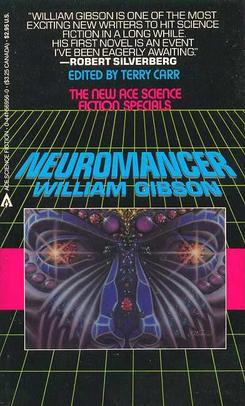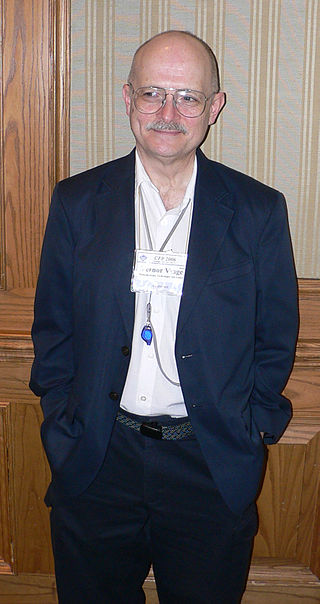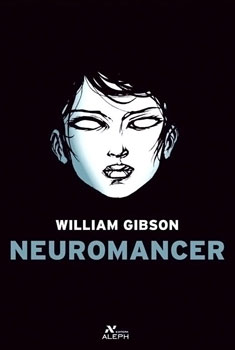Related Research Articles

Neuromancer is a 1984 science fiction novel by American-Canadian writer William Gibson. Considered one of the earliest and best-known works in the cyberpunk genre, it is the only novel to win the Nebula Award, the Philip K. Dick Award, and the Hugo Award. It was Gibson's debut novel and the beginning of the Sprawl trilogy. Set in the future, the novel follows Henry Case, a washed-up hacker hired for one last job, which brings him in contact with a powerful artificial intelligence.

Vernor Steffen Vinge is an American science fiction author and retired professor. He taught mathematics and computer science at San Diego State University. He is the first wide-scale popularizer of the technological singularity concept and among the first authors to present a fictional "cyberspace". He has won the Hugo Award for his novels A Fire Upon the Deep (1992), A Deepness in the Sky (1999), Rainbows End (2006), and novellas Fast Times at Fairmont High (2002), and The Cookie Monster (2004).

William Ford Gibson is an American-Canadian speculative fiction writer and essayist widely credited with pioneering the science fiction subgenre known as cyberpunk. Beginning his writing career in the late 1970s, his early works were noir, near-future stories that explored the effects of technology, cybernetics, and computer networks on humans, a "combination of lowlife and high tech"—and helped to create an iconography for the information age before the ubiquity of the Internet in the 1990s. Gibson coined the term "cyberspace" for "widespread, interconnected digital technology" in his short story "Burning Chrome" (1982), and later popularized the concept in his acclaimed debut novel Neuromancer (1984). These early works of Gibson's have been credited with "renovating" science fiction literature in the 1980s.

Gregory Dale Bear was an American writer and illustrator best known for science fiction. His work covered themes of galactic conflict, parallel universes, consciousness and cultural practices, and accelerated evolution. His last work was the 2021 novel The Unfinished Land. Greg Bear wrote over 50 books in total.

Michael Swanwick is an American fantasy and science fiction author who began publishing in the early 1980s.
The Three Californias Trilogy is a book trilogy by Kim Stanley Robinson, which depict three different possible futures of Orange County, California. The books that make up the trilogy are The Wild Shore, The Gold Coast and Pacific Edge. Each of these books describes the life of young people in the three different near-futures. All three novels begin with an excavation which tells the reader about the world they are entering.

Count Zero is a science fiction novel by American-Canadian writer William Gibson, originally published in 1986. It is the second volume of the Sprawl trilogy, which begins with Neuromancer and concludes with Mona Lisa Overdrive, and is a well-regarded early example of the cyberpunk subgenre.

Mona Lisa Overdrive is a science fiction novel by American-Canadian writer William Gibson, published in 1988. It is the final novel of the cyberpunk Sprawl trilogy, following Neuromancer and Count Zero, taking place eight years after the events of the latter. The novel was nominated for the Nebula Award for Best Novel, the Hugo Award for Best Novel, and the Locus Award for Best Science Fiction Novel in 1989.
Intrusion Countermeasures Electronics (ICE) is a term used in cyberpunk literature to refer to security programs which protect computerized data from being accessed by hackers.
Bobby Newmark is one of the main characters in the William Gibson novel Count Zero. His handle in the Matrix is "Count Zero", from which the novel derives its name. Newmark is one of several Gibson characters who live through information.

Molly Millions is a recurring character in stories and novels written by William Gibson, particularly his Sprawl trilogy. She first appeared in "Johnny Mnemonic", to which she makes an oblique reference in Neuromancer. She later appeared in Mona Lisa Overdrive under the name "Sally Shears".
The Bridge trilogy is a series of novels by William Gibson, his second after the successful Sprawl trilogy. The trilogy comprises the novels Virtual Light (1993), Idoru, (1996) and All Tomorrow's Parties (1999). A short story, "Skinner's Room", was originally composed for Visionary San Francisco, a 1990 museum exhibition exploring the future of San Francisco.

The Gaea Trilogy consists of three science fiction novels by John Varley. The stories tell of humanity's encounter with a living being in the shape of a 1,300 km diameter Stanford torus, inhabited by many different species, most notably the centaur-like Titanides, in orbit around the planet Saturn.

The works of William Gibson encompass literature, journalism, acting, recitation, and performance art. Primarily renowned as a novelist and short fiction writer in the cyberpunk milieu, Gibson invented the metaphor of cyberspace in "Burning Chrome" (1982) and emerged from obscurity in 1984 with the publication of his debut novel Neuromancer. Gibson's early short fiction is recognized as cyberpunk's finest work, effectively renovating the science fiction genre which had been hitherto considered widely insignificant.
"Burning Chrome" is a science fiction short story by Canadian-American writer William Gibson, first published in Omni in July 1982. Gibson first read the story at a science fiction convention in Denver, Colorado in the autumn of 1981, to an audience of four people, among them Bruce Sterling. It was nominated for a Nebula Award in 1983 and collected with the rest of Gibson's early short fiction in a 1986 volume of the same name.

Nora Keita Jemisin is an American science fiction and fantasy writer. Her fiction includes a wide range of themes, notably cultural conflict and oppression. Her debut novel, The Hundred Thousand Kingdoms, and the subsequent books in her Inheritance Trilogy received critical acclaim. She has won several awards for her work, including the Locus Award. The three books of her Broken Earth series made her the first author to win the Hugo Award for Best Novel in three consecutive years, as well as the first to win for all three novels in a trilogy. She won a fourth Hugo Award, for Best Novelette, in 2020 for Emergency Skin. Jemisin was a recipient of the MacArthur Fellows Program Genius Grant in 2020.

Ancillary Justice is a science fiction novel by the American writer Ann Leckie, published in 2013. It is Leckie's debut novel and the first in her Imperial Radch space opera trilogy, followed by Ancillary Sword (2014) and Ancillary Mercy (2015). The novel follows Breq—who is both the sole survivor of a starship destroyed by treachery and the vessel of that ship's artificial consciousness—as she seeks revenge against the ruler of her civilization. The cover art is by John Harris.
Neon Yang, formerly JY Yang, is a Singaporean writer of English-language speculative fiction best known for the Tensorate series of novellas published by Tor.com, which have been finalists for the Hugo Award, Locus Award, Nebula Award, World Fantasy Award, Lambda Literary Award, British Fantasy Award, and Kitschie Award. The first novella in the series, The Black Tides of Heaven, was named one of the 100 Best Fantasy Books of All Time by Time Magazine. Their debut novel, The Genesis of Misery, the first book in The Nullvoid Chronicles, was published in 2022 by Tor Books, received a starred review from Publishers Weekly, received a nomination for the 2022 Goodreads Choice Award for Science Fiction, and was a Finalist for the 2023 Locus Award for Best First Novel and 2023 Compton Crook Award.
"Press Enter ■" is a science fiction novella by American writer John Varley originally published in the May 1984 issue of Isaac Asimov's Science Fiction Magazine. In 1985 it won the Locus Award for Best Novella, Hugo Award for Best Novella and Nebula Award for Best Novella.
References
- ↑ Poole, Steven (October 3, 1996). "Cartesian Neon" . Retrieved September 24, 2008.
- ↑ "1984 Award Winners & Nominees". Worlds Without End. Retrieved 2009-07-17.
- ↑ "1985 Award Winners & Nominees". Worlds Without End. Retrieved 2009-07-17.
- ↑ "1986 Award Winners & Nominees". Worlds Without End. Retrieved 2009-07-17.
- ↑ "1987 Award Winners & Nominees". Worlds Without End. Retrieved 2009-07-17.
- ↑ "1989 Award Winners & Nominees". Worlds Without End. Retrieved 2009-07-17.